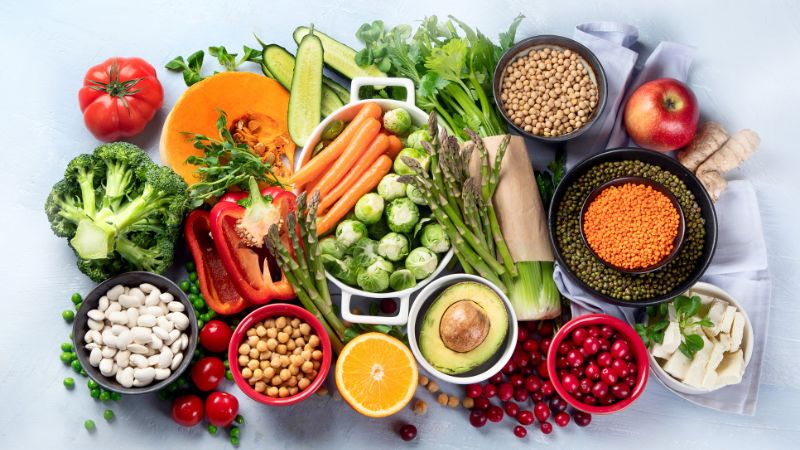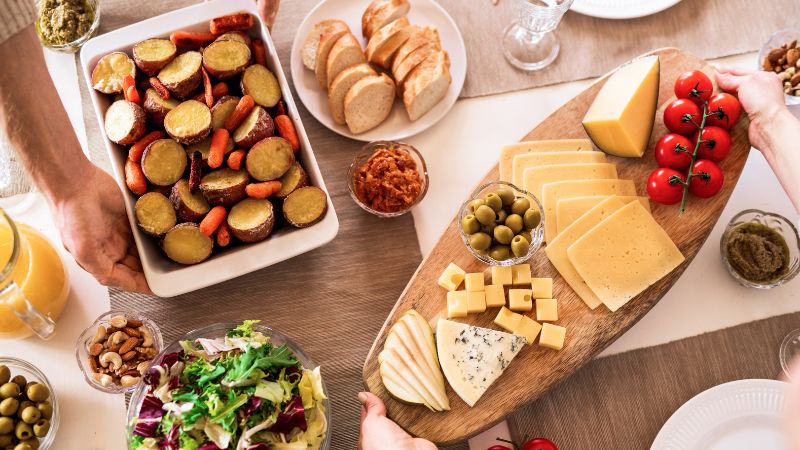Processed foods are convenient, but they also have limitations. Knowing how to classify and choose food intelligently will help us have a healthy diet. In this article, let’s distinguish between types of food by their processing methods and learn how to choose healthy foods!
1 Distinguishing Types of Food by Processing Methods
Food processing methods vary, ranging from simple techniques like freezing and grinding to complex processes that involve using additives to extend shelf life or enhance flavor.
The NOVA food classification system, recognized by the World Health Organization (WHO) and the Food and Agriculture Organization of the United Nations (FAO), categorizes food into four main groups:
Group 1: Unprocessed or Minimally Processed Foods
This group includes natural foods like fresh fruits, vegetables, meat, and whole grains. These foods undergo simple processing methods such as drying, freezing, chilling, filtering, fermenting, or vacuum packaging to make them more accessible and prolong their shelf life.
Group 2: Processed Culinary Ingredients
This group consists of ingredients derived from natural foods, such as oils, sugar, flour, and dried fruits and vegetables. These ingredients have undergone basic processing methods like pressing, refining, grinding, or drying for use in cooking.
 Distinguishing Types of Food by Processing Methods
Distinguishing Types of Food by Processing Methods
Group 3: Processed Foods
This group includes foods to which salt, oil, sugar, or other ingredients have been added, such as canned fruits, pickled vegetables, and fresh bread. These foods typically contain 2-3 ingredients and are often consumed alongside other dishes.
Group 4: Ultra-Processed Food and Drinks
This group comprises foods produced through complex industrial processes, involving multiple additives, sweeteners, and other ingredients. Examples include candies, ice cream, packaged snacks, and ready-to-eat frozen meals. Ultra-processed foods tend to be high in sugar, oil, salt, preservatives, artificial colors, and flavors…
2 Are Processed Foods Good for Health?
Advantages
Processed foods, including frozen, pre-cut, and canned options, offer several benefits to consumers. One notable advantage is the time-saving aspect of cooking, especially for busy individuals.
Additionally, some processed foods are fortified with essential nutrients to address deficiencies in vitamins and minerals. For instance, children’s cereals are often enriched with iron and vitamins to prevent anemia, milk is fortified with vitamin D to prevent rickets, flour is enriched with folic acid to reduce the risk of birth defects, and salt is iodized to prevent goiter.
Furthermore, certain food processing methods like pasteurization, cooking, and drying can destroy or inhibit the growth of harmful bacteria, ensuring food safety. This also prolongs the shelf life of food, preserving its original flavor, texture, aroma, and appearance, while making meal preparation more convenient and quicker.
 Are Processed Foods Good for Health?
Are Processed Foods Good for Health?
Disadvantages
Over-processing can reduce or eliminate essential nutrients. For example, peeling fruits, vegetables, and whole grains removes valuable phytochemicals and fiber. Heating or drying foods can also destroy certain vitamins and minerals. While manufacturers may add back some of the lost nutrients, it’s not always possible to compensate entirely.
Moreover, processed foods tend to be more easily digestible compared to their natural counterparts. As a result, the body burns fewer calories when consuming these foods. It is estimated that the number of calories burned from eating processed foods is only half that of unprocessed foods.
It’s important to note that foods with a high ratio of calories to low fiber and essential nutrient content are considered “nutrient-poor ultra-processed foods.” A classic example is soda, which provides a high number of calories from added sugar but offers little to no nutritional value. Overconsuming these types of foods increases the risk of obesity, diabetes, and cardiovascular disease.
3 How to Choose Foods for a Healthy Diet
Diet plays a crucial role in maintaining health. A healthy diet is encouraged to include mostly unprocessed or minimally processed foods while limiting heavily processed options, especially ultra-processed ones.
According to Associate Professor Dr. Nguyen Thi Lam, former Vice Director of the National Institute of Nutrition, a reasonable diet provides the body with essential macronutrients, micronutrients, and energy, catering to individual needs based on nutritional status, physiology, and physical activity.
 How to Choose Foods for a Healthy Diet
How to Choose Foods for a Healthy Diet
It is recommended to incorporate nutrient-dense foods like green vegetables, ripe fruits, whole grains, and legumes… while limiting the intake of sugary foods, sugary drinks, snacks, processed meats, and salt.
Additionally, meal planning can help control food intake, ensure nutritional balance, and prevent food waste. When shopping for groceries, prioritize fresh, high-quality ingredients that are beneficial to health, such as fish, lean meats, seasonal fruits and vegetables, whole grains, and nuts. Avoid highly processed and fast foods.
Cooking at home allows you to control the ingredients and quality of your meals, ensuring food safety and enhancing the effectiveness of a healthy diet.
Adopting a healthy diet is the foundation for good health and a balanced physique. Implement the above principles to develop a suitable eating plan, contributing to enhancing your quality of life and effectively preventing diseases!
Source: Sức khỏe và Đời sống Newspaper



































